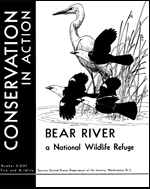United States Fish and Wildlife Service

United States Fish and Wildlife Service: Publications
Date of this Version
2008
Citation
Developed by the Association of Fish and Wildlife Agencies’ Migratory Shore and Upland Game Bird Support Task Force (2008) 16 pages.
Abstract
This Strategy contains recommendations for obtaining priority information needed to reduce the uncertainties underlying management decisions for two of the most important game birds in North America, mourning and white-winged doves. This strategy is intended to increase the financial support for management over the next five to 10 years with thoughtful and deliberate planning built on basic scientific principles.
The Task Force determined that convening a workshop of national dove experts to develop the strategy would be the most efficient and effective process. By invitation of the Migratory Shore and Upland Game Bird Working Group chairman, experts from state and federal agencies, flyways and universities were invited to the workshop. Experts from Canada and Mexico were also invited, but were unable to attend. The workshop was held February 12-14, 2008, at the U.S. Fish and Wildlife Service (FWS) Region 6 Office in Denver, Colorado.
By almost every measure, mourning and white-winged doves are critically important game birds in North America. The mourning dove is the most harvested migratory game bird species in the U.S. — nearly 20.7 million mourning doves were harvested by nearly 1.1 million hunters each year in 2005 and 2006.
In addition, mourning doves (and white-winged doves in the Southwest) are valued by the public in rural, suburban, and urban locales because they occur widely, nest readily around yards and farmsteads, and are frequent visitors to bird feeders (Schwertner et al., 2002).
The economic impact of dove hunting is considerable. The 2006 National Survey of Fishing, Hunting and Wildlife-Associated Recreation estimated that average annual expenditures for migratory bird hunters are $588 each.
Four priority information needs for mourning and white-winged doves have been determined:
1) A national banding program for doves.
2) A national dove parts collection survey.
3) Independent measures of abundance and/or trends for doves.
4) A database of predictors of dove vital rates.
Workshop participants identified four overarching guidelines that should be considered in further development of each of the priority information needs:
1) Consider the involvement of Canada and Mexico.
2) Account for differences in urban and rural doves.
3) Gather human dimensions information.
4) Consider the effects of climate or system change and its impacts on dove vital rates.
Priority information needs outlined in this Strategy will increase management population performance significantly by:
•Reducing uncertainty surrounding vital rates and management decisions;
• Enabling management actions to be more responsive to changes in vital rates; and
• Providing information to enable a more formal decision-making process.
Ultimately, these priorities help build on the foundation of current efforts in a way that ensures the long-term conservation and informed harvest management of these critically important birds in the face of a changing environment.

